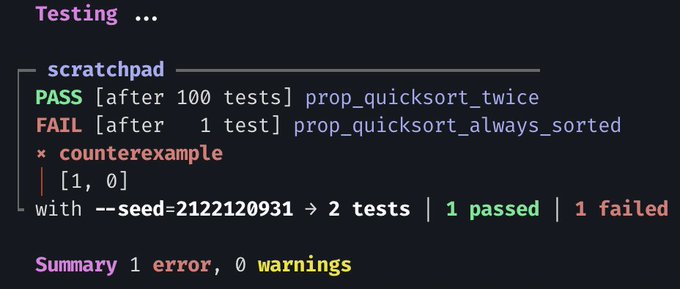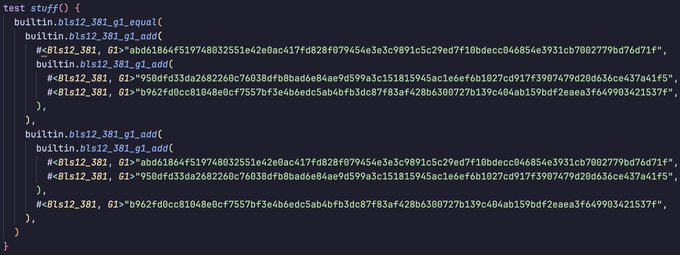
MicroProofs
@MicroProofs
Followers
2,320
Following
243
Media
35
Statuses
897
$Microproofs; Posting ideas and information about blockchain centered proofs in micro form. Aiken Core Maintainer: @aiken_eng
Blockchain
Joined October 2020
Don't wanna be here?
Send us removal request.
Explore trending content on Musk Viewer
Colorado
• 122080 Tweets
Notre Dame
• 108861 Tweets
Garcia
• 59851 Tweets
Kentucky
• 57243 Tweets
#precure
• 52679 Tweets
#仮面ライダーガヴ
• 46175 Tweets
The Weeknd
• 39975 Tweets
プリキュア
• 38565 Tweets
Anita
• 35227 Tweets
Northern Illinois
• 34752 Tweets
Iowa
• 34120 Tweets
#AEWAllOut
• 31594 Tweets
Nebraska
• 29323 Tweets
Abel
• 24136 Tweets
Carti
• 24078 Tweets
Auburn
• 23005 Tweets
#ブンブンジャー
• 21156 Tweets
#UFCVegas97
• 16195 Tweets
Talleres
• 11455 Tweets
ひろプリ
• 10529 Tweets
Last Seen Profiles
Hey Cardano community. I have a super nice poll for everyone to vote on!
Currently in Cardano if you send to a script with no datum (a piece of data about the sender) attached (whether that script was made with Aiken, Plu-ts, PlutusTx, Opshin, Helios, Scalus, etc.) it is locked
Delay to add Maybe Datum
545
Don't delay
419
67
116
156
We are entering a new era of testing on Aiken.
You may have looked at other blockchain testing frameworks and wondered "What If?"
Now Cardano will have some of the most robust and easy to use on chain tools.
I'm excited to see what ends up being built this year!
2
28
129
Let me know if you like long form threads on a particular topic. This is similar to the address threads I did on Cardano in the past.
12
5
84
Happy to start working at
@jpgstoreNFT
with
@scheredev
@blakelockbrown
and everyone else on this awesome team.
7
3
66
@ch1bo_
All accounts are kept on the L1, so your funds don't actually live on a L2 (like inside a single utxo on the L1), but rather you get a utxo per account. Then each zk-proof posted will modify each involved account utxo.
This way there is no leaf state. Since the utxo pertaining
2
4
62
To give an update.
The poll is pretty close, I spoke with CIP editors about this and came to 2 options
Maybe we can still squeeze this in PlutusV3 before the HF in August-September.
If not probably will be scrapped in favor of CIP-112 with the HF coming in Jan? maybe. This will
4
4
62
Part 2: Wallet Draining
Part 1 here:
So now that we understand how assets exist on a blockchain, we can get into the harrowing attacks called wallet draining.
3
26
60
Fine you people can’t even be satisfied with a simple admin/DAO solution for allowing assets to be recovered in the case of wrong or no datum, but keeping everything else decentralized. 🫠 Jk lol
So to alleviate the burning “must be decentralized at all costs” burden from your
@adamKDean
@ItsDave_ADA
I think of it like there would be a admin that can withdraw value sent to the smart contract with no datum or mismatching typed datum. From there the admin may choose to send it back to the sender (honest) or keep it (dishonest) but ultimately the power would be in the hands of
2
0
4
11
11
56
@cardano_whale
If there's any technical details about Cardano you want to make threads about, I'd be happy to coordinate with you. Lately I've been doing Cardano threads on how addresses work. It gets pretty technical further in.
1
1
41
I have many more contracts to make 😃. I enjoy writing the Aiken compiler as much as I like writing in Aiken.
1
6
38
Add a comment to the CIP if you actually care about reducing wasted block size. Increasing block size won't reduce v1 script size waste lol.
@hoskytoken
@MicahAlexKenda1
@SmaugPool
Here is the CIP.
If this gets rejected then PlutusV1 scripts will continue to populate blocks forever 😂
1
9
25
3
7
34
@cNFTfART
To make building easier we need funding to get these primitives finished. Shout out IOG to finish funding this work
9
16
30
@SebastienGllmt
@Padierfind
@PaimaStudios
@TarochiGame
@cardano_whale
@IOHK_Charles
@RichardMcCrackn
@bigpeyYT
@aiken_eng
@FarmerNash_
@scheredev
@nmkr_io
Yes. In fact I’ll add a little addendum. But I think with a with a modification to CIP-68 we can have a much better standard with only one extra NFT for metadata lookup. I’ll write a thread on this later. This way it wouldn’t require 2 NFTs per mint of the asset. 🎉
6
3
32
@monad_alexander
Here is Aiken. What is Aiken? Well it’s a language and set of tools for interacting and creating smart contracts in an easy way. The goal also is to create a reverse engineering tool to reverse all these onchain contracts 😈
0
4
28
Building Aiken has been one of the funnest projects I’ve tackled. There’s more cool stuff to come past this milestone 🎊
📣Exciting Announcement - Aiken's alpha phase has launched!📣
#Aiken
is an open source
#SmartContract
language & toolchain, specifically created to simplify & enhance the development of smart contracts on
#Cardano
.
Learn more below ⬇️⬇️⬇️
@aiken_eng
@rvcas
@_KtorZ_
@MicroProofs
26
287
1K
3
4
27
@hoskytoken
@MicahAlexKenda1
@SmaugPool
Here is the CIP.
If this gets rejected then PlutusV1 scripts will continue to populate blocks forever 😂
1
9
25
@cardano_whale
The issue I have with Solana is while the VM is different and it has its own implementation of functions similar to what’s in EVM, the smart contract standards came from Ethereum. And the Ethereum standards for smart contracts are atrocious.
2
0
22
@ch1bo_
Note there is not nearly as much storage/bloat saved in comparison to using a Data availability. Which compresses on-chain account information for minimal storage.
Instead the savings come in if I make 30 transactions with my account before the next zk proof is posted then those
3
0
22
@LusoAda
@ch1bo_
Think bigger. Imagine a “transient” layer basically a dapp smart contract that can do anything with cheaper fees. And occasionally your L1 account utxo is updated to match your current balance. Anytime you can initiate a withdrawal and you have an easy back door since your state
2
2
22
@flubdubster
@SLICENSPICE
@HeptaCardano
@DeFroppy
@JaromirTesar
A fix was already merged for the Chang hard fork. Now referencing a script costs bytes per a new param. So in the future this would likely cost more like 10-30ada
1
6
22
@MicheleHarmonic
It’s a bit more nuanced. Your script arguments still come in as data. So you either need to work with your arguments as Data like in PlutusV2 or spend the budget to convert arguments to SOP and then use them which might be higher or lower cost depending on how much you do after
2
1
20
@OptimFi
Why do you need a permission model when you already have an intent model. Simply using your private key or other verification to sign a message of intent is more than enough to prove which dapps you want to execute in a given transaction. I’m not sure why there is a permission
3
2
20
@DegenTravis
@wabdoteth
Any contract that switches over to using PlutusV2 can at any point remove the collateral requirements. To maintain backwards compatibility PlutusV1 was kept as is and will not have new features added to maintain consistency. But as projects go to V2 collateral will disappear.
2
0
18
@RichardMcCrackn
@the_ape_society
@jpgstoreNFT
@aiken_eng
Thanks so much for supporting Aiken. Everything helps and we have a lot of cool stuff coming in February
1
0
17
@jonahkoch
@ElRaulito_cnft
I’m making a contract I call “Bullet” (just a fun name) that allows for any kind of intention even enforcing another script is run. And the key interoperability feature is the contract can support 20+ intentions in a single tx. And the intentions don’t need to be from the same
3
2
17
@UnpopularEL
Yeah just need a smart token standard CIP with clawbacks and freezing. (A few are in progress) Make the risks transparent to users and let people decide what they like.
4
3
16
@amw7
@0xMetamatt
I’d recommend looking into moving forward with CIP-69[]
The main things left are pushing this as a community wanted feature and fleshing out the specs. This CIP solves 2 problems in one go. Allowing future spending scripts to be called without a datum and
1
4
16
I’ve been heads down working on finishing a few more code gen improvements before alpha. But I’m also really excited to have some time soon to build some different smart contracts in
@aiken_eng
. These will all be open source. In other words, more Aiken examples soon ;)
3
2
16
@Quantumplation
I’d say probably 2-3 months max. Possibly less. Talking with Lehin on github to see what can be done
1
1
15








































